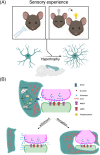The role of astrocyte structural plasticity in regulating neural circuit function and behavior
- PMID: 35535566
- PMCID: PMC9233050
- DOI: 10.1002/glia.24191
The role of astrocyte structural plasticity in regulating neural circuit function and behavior
Abstract
Brain circuits undergo substantial structural changes during development, driven by the formation, stabilization, and elimination of synapses. Synaptic connections continue to undergo experience-dependent structural rearrangements throughout life, which are postulated to underlie learning and memory. Astrocytes, a major glial cell type in the brain, are physically in contact with synaptic circuits through their structural ensheathment of synapses. Astrocytes strongly contribute to the remodeling of synaptic structures in healthy and diseased central nervous systems by regulating synaptic connectivity and behaviors. However, whether structural plasticity of astrocytes is involved in their critical functions at the synapse is unknown. This review will discuss the emerging evidence linking astrocytic structural plasticity to synaptic circuit remodeling and regulation of behaviors. Moreover, we will survey possible molecular and cellular mechanisms regulating the structural plasticity of astrocytes and their non-cell-autonomous effects on neuronal plasticity. Finally, we will discuss how astrocyte morphological changes in different physiological states and disease conditions contribute to neuronal circuit function and dysfunction.
Keywords: astrocytes; behavior; perisynaptic astrocyte processes; physiological states; synapses.
© 2022 The Authors. GLIA published by Wiley Periodicals LLC.
Conflict of interest statement
The authors declare no potential conflict of interest.
Figures




Similar articles
-
Astrocytes regulate neuronal network activity by mediating synapse remodeling.Neurosci Res. 2023 Feb;187:3-13. doi: 10.1016/j.neures.2022.09.007. Epub 2022 Sep 25. Neurosci Res. 2023. PMID: 36170922 Review.
-
Functional Consequences of Synapse Remodeling Following Astrocyte-Specific Regulation of Ephrin-B1 in the Adult Hippocampus.J Neurosci. 2018 Jun 20;38(25):5710-5726. doi: 10.1523/JNEUROSCI.3618-17.2018. Epub 2018 May 23. J Neurosci. 2018. PMID: 29793972 Free PMC article.
-
Microglia regulate synaptic development and plasticity.Dev Neurobiol. 2021 Jul;81(5):568-590. doi: 10.1002/dneu.22814. Epub 2021 Mar 8. Dev Neurobiol. 2021. PMID: 33583110 Free PMC article. Review.
-
Morphological plasticity of astroglia: Understanding synaptic microenvironment.Glia. 2015 Dec;63(12):2133-51. doi: 10.1002/glia.22821. Epub 2015 Mar 18. Glia. 2015. PMID: 25782611 Free PMC article. Review.
-
Molecular Mechanisms of Astrocyte Involvement in Synaptogenesis and Brain Synaptic Plasticity.Biochemistry (Mosc). 2023 Apr;88(4):502-514. doi: 10.1134/S0006297923040065. Biochemistry (Mosc). 2023. PMID: 37080936 Review.
Cited by
-
The crosstalk between CNS resident glial cells and peripheral immune cells is critical for age-dependent demyelination and subsequent remyelination.Biogerontology. 2025 Mar 14;26(2):74. doi: 10.1007/s10522-025-10213-2. Biogerontology. 2025. PMID: 40085264 Review.
-
Primary cilia signaling in astrocytes mediates development and regional-specific functional specification.Nat Neurosci. 2024 Sep;27(9):1708-1720. doi: 10.1038/s41593-024-01726-z. Epub 2024 Aug 5. Nat Neurosci. 2024. PMID: 39103557
-
Astrocytes require perineuronal nets to maintain synaptic homeostasis in mice.Nat Neurosci. 2024 Aug;27(8):1475-1488. doi: 10.1038/s41593-024-01714-3. Epub 2024 Jul 17. Nat Neurosci. 2024. PMID: 39020018 Free PMC article.
-
Experience-dependent glial pruning of synaptic glomeruli during the critical period.Sci Rep. 2024 Apr 20;14(1):9110. doi: 10.1038/s41598-024-59942-3. Sci Rep. 2024. PMID: 38643298 Free PMC article.
-
Intracellular Ca2+ waves in mammalian cells.Biol Futur. 2025 Jun 29. doi: 10.1007/s42977-025-00270-6. Online ahead of print. Biol Futur. 2025. PMID: 40581908 Review.
References
-
- Adamsky, A. , Kol, A. , Kreisel, T. , Doron, A. , Ozeri‐Engelhard, N. , Melcer, T. , Refaeli, R. , Horn, H. , Regev, L. , Groysman, M. , London, M. , & Goshen, I. (2018). Astrocytic activation generates de novo neuronal potentiation and memory enhancement. Cell, 174, 59–71.e14. 10.1016/j.cell.2018.05.002 - DOI - PubMed
-
- Agarwal, A. , Wu, P. H. , Hughes, E. G. , Fukaya, M. , Tischfield, M. A. , Langseth, A. J. , Wirtz, D. , & Bergles, D. E. (2017). Transient opening of the mitochondrial permeability transition pore induces microdomain calcium transients in astrocyte processes. Neuron, 93, 587–605.e7. 10.1016/j.neuron.2016.12.034 - DOI - PMC - PubMed
Publication types
MeSH terms
Grants and funding
LinkOut - more resources
Full Text Sources

